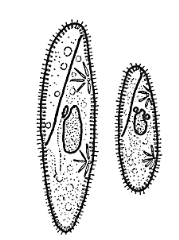1. Barophilic prokaryotes
a) Readily grow and divide in sea water enriched in any soluble salt of barium
b) Grow slowly in highly alkaline frozen lakes at high altitudes
c) Occur in water containing high concentration of barium hydroxide
d) Grow and multiply in very deep marine sediments
2. For retting of jute the fermenting microbe used in
a) Streptococcus lactin
b) Methophilic bacteria
c) Heliobacter pylori
d) Butyric acid bacteria
3. Which of the following unicellular organisms has a macronucleus for trophic function and one or more micronuclei for reproduction?
 a) Euglena
a) Euglena
b) Paramecium
c) Trypanosoma
d) Amoeba
4. The catalytic efficiency of two different enzymes can be compared by
a) formation of product
b) The Km value
c) molecular size of the enzyme
d) the pH of optimum value
5. In contrast to annelids the platyhelminthes show
a) Absence of body cavity
b) Radial symmetry
c) Presence of pseudocoel
d) Bilateral symmetry
6. Photosynthetic active radiation (PAR) has the following range of wavelength
a) 340-450 nm
b) 400-700 nm
c) 450-950 nm
d) 500-600 nm
7. Three crops that contribute maximum to global food grain production are
a) wheat, rice and maize
b) wheat, rice and barley
c) Wheat, maize and sorghum
d) Rice, maize and sorghum
8. Secretin and cholecystokinin are digestive hormones. They are secreted in
a) Duodenum
b) ileum
c) Oesophagum
d) Pyloric stomach
9. AIDS is caused by HIV that principally infect
a) All lymphocytes
b) Activator B cells
c) Cytotoxic T cells
d) T4 lymphocytes
10. Identify the correctly matched pair
a) Kyoto Protocol-Climatic change
b) Ramsar convention -Groundwater pollution
c) Montreal Protocol - Global warming
d) Basal convention - Biodiversity conservation
Answers
1. d) Grow and multiply in very deep marine sediments
2. d) Butyric acid bacteria
3. b) Paramecium
4. b) The Km value
5. a) Absence of body cavity
6. b) 400-700 nm
7. a) wheat, rice and maize
8. a) Duodenum
9. c) Cytotoxic T cells
10. a) Kyoto Protocol-Climatic change
a) Readily grow and divide in sea water enriched in any soluble salt of barium
b) Grow slowly in highly alkaline frozen lakes at high altitudes
c) Occur in water containing high concentration of barium hydroxide
d) Grow and multiply in very deep marine sediments
2. For retting of jute the fermenting microbe used in
a) Streptococcus lactin
b) Methophilic bacteria
c) Heliobacter pylori
d) Butyric acid bacteria
3. Which of the following unicellular organisms has a macronucleus for trophic function and one or more micronuclei for reproduction?
 a) Euglena
a) Euglenab) Paramecium
c) Trypanosoma
d) Amoeba
4. The catalytic efficiency of two different enzymes can be compared by
a) formation of product
b) The Km value
c) molecular size of the enzyme
d) the pH of optimum value
5. In contrast to annelids the platyhelminthes show
a) Absence of body cavity
b) Radial symmetry
c) Presence of pseudocoel
d) Bilateral symmetry
6. Photosynthetic active radiation (PAR) has the following range of wavelength
a) 340-450 nm
b) 400-700 nm
c) 450-950 nm
d) 500-600 nm
7. Three crops that contribute maximum to global food grain production are
a) wheat, rice and maize
b) wheat, rice and barley
c) Wheat, maize and sorghum
d) Rice, maize and sorghum
8. Secretin and cholecystokinin are digestive hormones. They are secreted in
a) Duodenum
b) ileum
c) Oesophagum
d) Pyloric stomach
9. AIDS is caused by HIV that principally infect
a) All lymphocytes
b) Activator B cells
c) Cytotoxic T cells
d) T4 lymphocytes
10. Identify the correctly matched pair
a) Kyoto Protocol-Climatic change
b) Ramsar convention -Groundwater pollution
c) Montreal Protocol - Global warming
d) Basal convention - Biodiversity conservation
Answers
1. d) Grow and multiply in very deep marine sediments
2. d) Butyric acid bacteria
3. b) Paramecium
4. b) The Km value
5. a) Absence of body cavity
6. b) 400-700 nm
7. a) wheat, rice and maize
8. a) Duodenum
9. c) Cytotoxic T cells
10. a) Kyoto Protocol-Climatic change